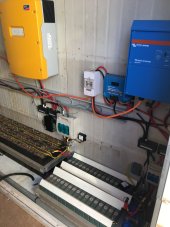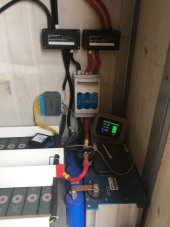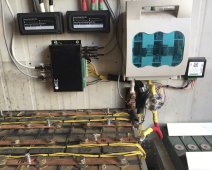Forgive me if you posted this elsewhere, but did you have a full guide with parts to program laid out somewhere?
My system is as follows:
Primary system:
32 cells 2p16s LiFeTech lithium 200ah
REC BMS / Gigavac contactors for main disconnect and DC PV disconnect
NT00 fuse/ disconnect
2x4 pole 300a busbars
Sunny Island 8.0H hybrid inverter
SunnyBoy SB1700 PV inverter
Outback Flexmax FM80 DC charger
Auxiliary system (high inductive loads)
32 cells 2p16s Sinopoly 100ah
Maxwell Supercapacitor
ZEVA BMS / Gigavac contactors for main and PV disconnect (REC precharge)
NH00 fuse/disconnect
2x4 pole 300a busbars
Victron Phoenix 48/5000 inverter
Victron 150/70 DC controller.
240V to 48V charger fed from Kubota J108 generator.
Auxiliary system feeds into generator input of Sunny Island.
System housed in a climate controlled enclosure constructed from 100mm coolroom panel.
As i have said, it isn’t as pretty as a rack mount or enclosed system, but it is more functional.
I don’t take many pictures, but i have some from when i was changing from batrium to REC.
The way the enclosure is setup makes taking photos of the entire setup difficult, there is essentially a sliding panel that seals the whole area.







